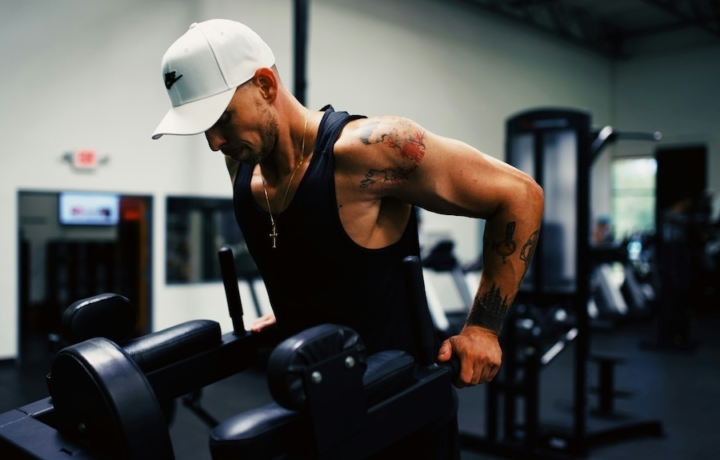Exercise
Lever Chest Press

Lever Chest Press
How to Perform
- Adjust the seat height so your chest aligns with the handles and your feet are firmly planted on the floor or footrests.
- Grasp the handles with a full grip, keeping your wrists straight and elbows slightly below shoulder height.
- Sit with your back firmly against the pad, maintaining a neutral spine position throughout the exercise.
- Take a deep breath in and brace your core muscles to stabilize your torso.
- Push the handles forward by extending your arms, exhaling steadily through the exertion phase.
- Maintain control as you press forward, avoiding locking your elbows at full extension to keep tension on the chest muscles.
- Slowly return to the starting position while inhaling, allowing your chest muscles to stretch slightly as the handles come back toward your body.
- Keep your shoulders pulled back and down throughout the movement to maximize chest engagement and protect your shoulder joints.
Important information
- Adjust the weight before beginning, starting lighter than you think you need until you master proper form.
- Keep your head neutral and avoid jutting your chin forward during the pressing motion.
- Make sure both sides of the chest are working equally—don't allow one arm to do more work than the other.
- If you feel pain in your shoulders rather than work in your chest, check your hand position and consider adjusting the seat height.

Lever Chest Press
Exercise Details
Primary Muscles
Muscle Groups
Mechanic
Risk Areas
Built for progress
Take the guesswork out of training
Create personalized AI-powered workout plans that evolve with you. Train smarter, track every rep and keep moving forward, one workout at a time.






The Lever Chest Press stands as a quintessential chest-building movement in any serious bodybuilding regimen, offering intermediate lifters a superb option for developing impressive pectoral definition and substantial triceps strength. This machine-based exercise provides a fixed movement pattern that allows for focused tension on the target muscles while minimizing the stabilization demands that come with free-weight alternatives.
As a compound movement primarily targeting the pectoralis major and minor, the Lever Chest Press simultaneously engages the anterior deltoids and triceps brachii as crucial secondary movers. This synergistic muscle recruitment makes it particularly valuable for bodybuilders seeking balanced upper body development and proportional aesthetics. The mechanical advantage offered by the lever system enables lifters to handle heavier loads with reduced risk compared to barbell or dumbbell pressing movements.
For strength-focused athletes, the Lever Chest Press delivers consistent resistance throughout the movement arc, creating an optimal environment for progressive overload—the fundamental principle behind muscle growth and strength gains. The fixed path of motion allows users to concentrate entirely on force production rather than stabilization, making this an excellent choice for those dedicated training sessions where maximum chest fiber recruitment is the goal.
Many bodybuilders incorporate this exercise into their chest routines as either a primary movement for heavy loading or as a finishing exercise to achieve complete muscle fatigue. The adjustable seat and handle positions on most Lever Press machines allow for customization to different body types and training objectives, whether targeting the upper, middle, or lower portions of the chest depending on the specific angle selected.
While machines like the Lever Chest Press were once dismissed by some strength purists, modern exercise science recognizes their value in a comprehensive resistance training program, particularly for hypertrophy goals. The controlled nature of this movement makes it especially effective for implementing intensity techniques like drop sets, rest-pause training, or tempo manipulation to push past plateaus and stimulate new muscle growth.
FAQ - Lever Chest Press
The Lever Chest Press primarily targets the pectoralis major and minor (chest muscles), while also engaging the anterior deltoids (front shoulders) and triceps brachii as secondary movers. This compound movement creates balanced upper body development, making it ideal for bodybuilders seeking proportional aesthetics.
Neither is universally "better" – they serve different purposes. The Lever Chest Press offers a fixed movement pattern that allows for heavier loading with reduced stabilization demands, making it excellent for focused chest development and progressive overload. Free weights provide greater stabilizer muscle recruitment and functional strength benefits.
Most Lever Chest Press machines feature adjustable seat and handle positions. Set the seat higher with handles at chest level to emphasize the lower chest, position the seat in the middle for overall chest development, or lower the seat with handles at shoulder level to target the upper chest region.
Avoid arching your back excessively, using momentum to move the weight, or setting the seat/handles improperly for your body proportions. Also, don't lock your elbows at the top of the movement, as this places excessive stress on the joint and reduces tension on the chest muscles.
For optimal results, include the Lever Chest Press 1-2 times weekly as part of your chest training. Allow 48-72 hours between chest sessions for adequate recovery, and consider alternating between the Lever Press and free weight pressing movements to provide varied stimulus for continued growth.







